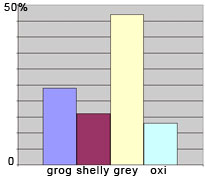| Main Fabric Categories |
Sherds |
% |
Grams |
% |
 |
| Grogged |
381 |
24 |
5,127 |
33 |
| Calcite-gritted (shelly) |
245 |
16 |
2,107 |
14 |
| Reduced grey ware |
740 |
47 |
6,062 |
39 |
| Oxidised |
196 |
13 |
2,119 |
14 |
| Total Roman sherds |
1,562 |
100
|
15,415
|
100 |
The majority of vessels are course ware (grey, grogged, shelly). The oxidised element of the assemblage is consistent with the percentage of fineware found at other sites.
The grogged ware element is siginificant and reflects a continuation of the local native tradition of pottery production.
The lower overall percentage of greyware, although reflecting a preference for wheel-thrown, mass produced goods, indicates a lower level of consumption of greyware on this site.
Calcite-gritted vessels are more extensively represented in the assemblage than at neighbouring sites, reflecting a robust trading link to the manufacturing area along the Northamptonshire-Bedfordshire border.
| Chronology (AD) |
Sherds |
% |
Grams |
% |
 |
PHASE 1a + PHASE 1b
All early Roman pottery
(c25 - c125) |
322 |
29 |
2,486 |
30 |
PHASE 2
Mid Roman (c125/150 - c275/300) |
661 |
51 |
6,705 |
59 |
PHASE 3
Late Roman (c 275/300 - 400+) |
111 |
10 |
1,218 |
11 |
Total diagnostically datable
Roman pottery sherds |
1,094 |
100 |
11,409 |
100 |
According to the pottery analysis, activity increased dramatically during the late 1st to mid 2nd century (phase 1), peaking in the mid Roman period (phase 2). The late period (phase 3) reflects a strong occupation of the site and continued economic activity.
| Chronology (AD) |
Sherds |
% |
Grams |
% |
PHASE 1a
Early Roman 1
(mid 1st to early 2nd)
grogged ware only |
52 |
18 |
664 |
21 |
PHASE 1b
Early Roman 2
(late 1st to mid 2nd)
grogged ware only |
230 |
82 |
2,540 |
79 |
Further analysis of the pottery from the earliest phases of activity indicates that the development of Romanisation at this site began in the late Agricolan period through to the early Trajanic, rather than during the conquest period.

